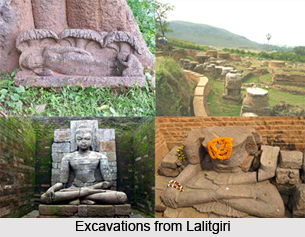 Excavations in Lalitgiri deals with the excavations carried out by the Archaeological Survey of India.
Excavations in Lalitgiri deals with the excavations carried out by the Archaeological Survey of India.
Excavations in Lalitgiri reveals the glorious times of Buddhism in early India. Archaeologists have unearthed remnants of a large stupa on the hill. Within the stupa, two rare stone caskets were found with relics of Gautama Buddha. This was the first such find in Eastern India like West Bengal and Odisha.
Stone Caskets of Lalitgiri
The stone caskets of Lalitgiri like Chinese Puzzle boxes, made of Khondalite stone, revealed three other boxes within them, made of steatite, silver and gold respectively; the gold casket, which is the last one, contained a relic or dhatu in the form of a small piece of bone.
Chaityagriha in Lalitgiri
There is another interesting facts regarding Lalitgiri find is that of an east facing apsidal chaityagriha, built of bricks, 33 by 11 metres (108 ft x 36 ft) in size with 3.3 metres (11 ft)-thick walls. This edifice, the first such Buddhist structure found in Odisha, contains a circular stupa at its centre.
Inscriptions in Lalitgiri
There the inscriptions are found were a series of Kushana Brahmi coins series made on shells with cuts on moonstone at the periphery of the edifice. Another find is a piece of a pillar railing with a lens-shaped decoration with the theme of a half lotus medallion. From these finds it is inferred that such structures belonged from the early Christian era to 6th-7th century period.
Central structure of Lalitgiri
The first and the largest monastery of Lalitgiri, facing east, a two storied structure measuring 36 square metres (390 sq ft), has at its center a 12.9 metres square open space; it is dated to 10th-11th century AD. Adjoining the monastery at the rear end is a rainwater cistern built of bricks. The second monastery, in the northern extremity of the hill, is believed to have been built when Buddhism was losing its importance in Lalitgiri. The third monastery faces south-east and has dimensions of 28 by 27 metres with a central open space of 8 square metres and represents the end stages of apsidal chaitya. The fourth monastery, 30 square metres (320 sq ft), in size, has many large sized Buddha heads deified in the sanctum sanctorum. A terracotta monastic seal with the inscription "Sri Chandraditya Vihara Samagra Arya Vikshu Sanghasa" is dated to the 9th-10th century AD.
Antiquities in Lalitgiri
The antiquities unearthed include a plethora of images of Gautama Buddha in different meditative forms from the Mahayana Buddhism period. The finds also include a gold pendant, silver jewellery, stone tablets with imprints of Ganesha and Mahisasurmardini, a seal matrix-cum-pendant, and a small image of Avalokitesvara.
Idols Found from Lalitgiri
The images of Tara in the form of Tara Kurukulla or Kurukulla Tara have been reported in Lalitgiri and also from Udayagiri and Ratnagiri, including an emanation form of Amitabha seated in a Lalitasana posture. The images of Hariti have also been found in Lalitgiri and also in Udayagiri and Ratnagiri. These images portray the goddess in a seated position, breast feeding a child or with the child seated in its lap. Hariti was once a child abductor, but Buddha persuaded her to become the protector of children.



















